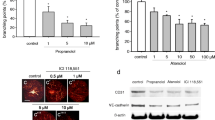Abstract
β-Adrenoreceptor has been studied in a clonal capillary endothelial cell line established from the vascular bed of the bovine adrenal medulla. [3H]Dihydroalprenolol ([3H]DHA) binding to the isolated plasma membranes from these cells has demonstrated the presence of β-adrenoreceptors with two different affinities. the dissociation constants (Kd) have been found to be 0.27±0.09×10−9 M and 2.96±0.31×10−9 M, respectively with the corresponding Bmax of 5.1±0.05 and 70.0±0.2 pmol/mg protein, respectively. Inhibition of [3H]DHA binding to the β-receptor by atenolol (a β1-antagonist) and ICI 118,551 (a β1-antagonist) has suggested that the IC50cor (=Ki) for atenolol and ICI 118,551 for high affinity site are 0.08±0.03×10−12 M and 0.25±0.08×10−12 M, respectively. This, therefore, indicates that both atenolol and ICI 118,551 are able to displace the bound ligand effectively but the β1-selective antagonist atenolol is 3 times more potent than its β2 counterpart, ICI 118,551. Displacement of [3H]DHA binding to the endothelial cell plasma membrane by the agonists isoproterenol, epinephrine and norephinephrine has established a relative order of Ki for these agents as isoproterenol (0.56±0.19×10−9 M)<epinephrine (0.77±0.26−9 M)>-norepinephrine (0.71±0.24×10−9 M) for the high affinity site. The corresponding values for the low affinity site, however, are 4.62±0.64×10−9 M, 6.21±0.86×10−9 M and 5.90±0.82×10−9 M, respectively for the same agonists. Increased intracellular cAMP accompanied with cellular proliferation in the presence of isoproterenol has suggested not only the coupling of β-adrenoreceptors to the adenylate cyclase system but also its involvement in endothelial cell proliferation.
Similar content being viewed by others
Abbreviations
- DHA:
-
Dihydroalprenolol
- cAMP:
-
3′:5′ cyclic adenosine monophosphate
- DTT:
-
dithiothreitol
- MEM:
-
minimal essential medium
- 8Br-cAMP:
-
8-bromo-adenosine 3′:5′ cyclic monophosphate
References
Smith AD, Winkler H: Fundamental mechanism in the release of catecholamines. In: Handbook Exp Pharmacol 33:538–605, 1972
Coupland RE: Electron microscopic observations on the structure of the rat adrenal medulla. The ultrastructure and organization of chromaffin cell in the normal adrenal medulla. J Anat 99:231–254, 1965
Maximow AA, Bloom W: In: A textbook of histology (6th ed.), WB Saunders, Philadelphia, p 299–307, 1953
Viveros OH: Mechanism of secretion of catecholamines from adrenal medulla. In: Handbook Physiol Endocrinol 389–426, 1975
Unger A, Phillips JH: Regulation of the adrenal medulla. Physiol Rev 63: 787–843, 1983
Pollard HB, Ornberg R, Levine M, Kelner K, Morita K, Levine R, Forsberg E, Brocklehurst KW, Duong L, Lelkes PI, Heldman E, Youdim M: Hormone secretion by exocytosis with emphasis on information from the chromaffin cell system. Vit and Hormones 42:109–196, 1985
Banerjee DK, Ornberg RO, Youdim MBH, Heldman E, Pollard HB: Endothelial cells from bovine adrenal medulla develop capillary-like growth pattern in culture. Proc Natl Acad Sci USA 82:4702–4706, 1985
Banerjee DK: Microen vironment of endothelial cell growth and Man-P-Dol synthase activity. Indian J Biochem Biophys 25:8–13, 1988
Oliveira CM, Banerjee DK: Role of extracellular signaling on endothelial cell proliferation and protein N-glycosylation. J Cell Physiol 144: 467–472, 1990
Brush JS, Tavárez-Pagán JJ, Banerjee DK: Insulin and insulin like growth factor-1 manifests differential activity in a clonal capillary endothelial cell line. Biochem Intl 25:537–545, 1991
Youdim MBH, Banerjee DK, Kelner K, Offutt L, Pollard HB: Steroid regulation of monoamine oxidase activity in the adrenal medulla. FASEB J 3:1753–1759, 1989
Pollard HB, Pazoles CJ, Creutz CE, Scott JH, Zinder O, Hotchkiss AQ: An osmotic mechanism for exocytosis from dissociated chromaffin cells. J Biol Chem 259:1114–1121, 1984
Das SK, Sikpi MO, Skolnick P: Heterogeneity of β-adrenoreceptors in guinea pig alveolar type II cells. Biochem Biophys Res Commun 142: 898–903, 1987
Bradford MM: A rapid and sensitive method for the quantitation of microgram quantities of protein utilizing the protein-dye binding. Analyt Biochem 72:248–254, 1976
Bennet JP: Methods in binding sites. In: H.I. Yamamura, S.J. Enna and M.J. Kuhar (eds). Neurotrasmitter receptor binding. Raven Press, New York, pp 57–90, 1978
Kuchler RJ: Biochemical methods in cell culture and virology. Dowden, Hutchinson and Ross Inc., Stroudsburg, Pennsylvania, pp 3–44, 1977
Auerbach R: Angiogenesis-inducing factors: A review. In: E. Pick (ed). Lymphokines Vol. 4, Academic Press, New York, pp 69–88, 1981
Gullino PM: Angiogenesis factor(s). In: R. Baserga (ed). Tissue growth factors. Springer-Verlag, Berlin, pp 427–449, 1981
Schor AM, Schor SL: Tumor angiogenesis. J Pathol 141:385–413, 1983
Folkman J, Klagsbrun M: Angiogenesis factors. Science 235:442–447, 1987
Neve KA, Mcgonigl P, Molinoff PB: Quantitation analysis of the selectivity of radioligands for subtypes of β-adrenergic receptors. J Pharmacol Exp Ther 238:46–53, 1986
Limberd LE: Cell surface receptors: A short course on theory and methods. Martinus Publishing, Boston, pp 75–115, 1986
Steinberg SF, Jaffe EA, Bilezikian JP: Role of β2-adrenoreceptor blockade and circulating adrenaline level for the pressor responses to β-adrenoceptor blocking drugs in rats. Nauyn-Schmiedeberg's Arch Pharmacol 325:310–313, 1984
Durieu-Trautmann O, Foignant N, Strosberg AD, Couraud OO: Coexpression of β1- and β2-adrenergic receptors on bovine brain capillary endothelial cells in culture. J Neurochem 56:775–781, 1991
Banerjee DK, Youdim MBH, Pollard HB: Cultured capillary endothelial cells from bovine adrenal medulla possess differential monoamine metabolic activity. J Pharm Pharmacol 36:15W, 1984
Levitzki A: β-Adrenergic receptor and their mode of coupling to adenylate cyclase. Physiol Rev 66:819–854, 1986
Banerjee DK: Regulation of mannosylphosphoryldolichol synthase activity by cAMP-dependent protein phosphorylation. In: A. Kotyk, J. Skoda, V. Paces and V. Kostka (eds). Highlights of Modern Biochemistry. VSP International Science Publishers, Zeist, Netherlands, pp 329–388, 1989
Author information
Authors and Affiliations
Rights and permissions
About this article
Cite this article
Das, S.K., Mukherjee, S. & Banerjee, D.K. β-Adrenoreceptors of multiple affinities in a clonal capillary endothelial cell line and its functional implication. Mol Cell Biochem 140, 49–54 (1994). https://doi.org/10.1007/BF00928365
Received:
Accepted:
Issue Date:
DOI: https://doi.org/10.1007/BF00928365



